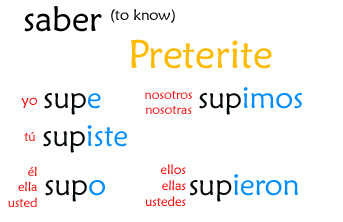Understanding the meaning of Spanish verbs is an essential part of the process of learning Spanish. Moreover, it is also necessary to understand how to conjugate these verbs. In this article, we have described everything about saber conjugation.
Knowing that the English verb “to know” in Spanish means both saber and conocer will help you in conversations.
However, we use the verb “know” without even realising it in English, and it is pretty much the same in Spanish.
The saber conjugations, like any other set of irregular verb conjugations, have their own quirks. The transition from the prefix sab- to the prefixes sup- and sep- is a significant one that can be difficult to master at first.
This, however, is a two-tiered procedure. The first step is to memorise the conjugations, and practising them in real-life conversations will help you develop a natural feel for even the most unusual saber conjugation.

Saber conjugation spanish
People are constantly learning new things. For example, we go to school because there are important things we must learn. We also need to be informed about current events, or we may want to get to know someone better.
As you can see, the verb “to know” is an important one in English. In Spanish, however, this verb is translated as two different verbs: saber and conocer. The meaning of both the verbs is “to be aware,” but we generally use them in different contexts.
Saber is the verb to use when discussing facts, information, or how to do something. Conocer, on the other hand, is a verb that refers to knowing people, places, or things.
When deciding when to use these two verbs, consider whether you can substitute the verb “to know” in English for the verb “to meet.” If this is the case, you should probably use conocer instead of saber.
Saber is an irregular verb, which means it does not conjugate in the most common way in Spanish. The saber conjugations follow a distinct pattern.
Read Also:Caim meaning- origin, symbol, use, and FAQs
This verb is irregular in the preterite, future, conditional, and present tense of the subjunctive mood, as well as in the first person of the present indicative.
Saber conjugation chart
Saber conjugation indicative
Simple tense
Let us take a look at the indicative mood of the saber conjugation set, which is divided into simple tenses and compound tenses. Remember that the auxiliary verb haber is included in compound tenses (to have).
Moreover, the subjects in any given language are I, you (singular), he/her (singular), we, you (plural) and he/her (plural). However, the Spanish words for these are yo, tu, él/ells, nosotros, ustedes and ellos/ellas. So, we conjugate regular or irregular verbs with these subjects. So, now, let us look at some simple tenses of the indicative mood.
1. Saber conjugation present tense –
The verb translates to “know”
- Yo sé – This translates to ‘i know’
- Tu sabes – again, this translates ‘you know’
- Él/Ella save – Next, this translates to ‘he/she knows’
- Nostoros sabemos – So, this translates to ‘We know’
- Ustedes saben – Again, this translates to ‘They know’
- Ellos/ellas saben – Finally, this translates to ‘they know’ also.
2. Saber conjugation preterite tense –
The verb translates to “knew”
- yo supe – This translates to ‘i knew’
- Tu supiste – Again, this translates to ‘you knew’
- Él/Ella supo -Next, this translates to ‘he/she knew’
- Nosotros supimos – this translates to ‘we knew’
- Ustedes supieron – Then, this translates to ‘they knew’
- Ellos/ellas supieron – Finally, this translates to ‘they knew’
3. Saber conjugation imperfect tense –
Again, the verb translates to “knew” as well
- yo sabría – This translates to ‘i knew’
- Tu sabrías – Again, this translates to ‘you knew’
- Él/Ella sabría – Next, this translates to ‘he/she knew’
- Nosotros sabríamos – Again, this translates to ‘we knew’
- Ustedes sabrían – So, Then, this translates to ‘they knew’
- Ellos/ellas sabrían – Finally, this translates to ‘they knew’
4. Saber conjugation future tense –
The verb translates to “will know”
- yo saber – This translates to ‘i will know’
- Tu sabrás – Then, this translates to ‘you will know’
- Él/Ella sabrá – Next, this translates to ‘he/she will know’
- Nosotros sabemos – This translates to ‘we will know’
- Ustedes sabrán – Again, this translates to ‘they will know’.
- Ellos/ellas sabrán – Finally, this translates to ‘they will know’.
Compound tense
1. Present perfect tense –
It translates to have/has known
- Yo he sabido – This translates to ‘i have known’
- Tú has sabido – Again, this translates to ‘You have known’
- él/ella ha sabido – Then, this translates to ‘he/she has known’
- Nosotros hemos sabido – Also, this translates to ‘we have known’
- Ustedes han sabido – Next, this translates to ‘they have known’
- ellos/ellas han sabido – Finally, it translates to ‘they have known’
2. Preterite perfect tense –
It means had known
- Yo hube sabido – This translates to ‘i had known’.
- Tú hubiste sabido – Next, it translates to ‘you had known’
- él/ella hubo sabido – Again, this translates to ‘he/she had known’
- Nosotros hubimos sabido – Then, this translates to ‘we had known’
- Ustedes hubieron sabido – This translates to ‘they had known’
- ellos/ellas hubieron sabido – Finally, this also translates to ‘they had known’
3. Past perfect or Pluperfect tense –
It means had known
- Yo había sabido – This translates to ‘i had known’.
- Tú habías sabido – Next, it translates to ‘you had known’
- él/ella había sabido – Again, this translates to ‘he/she had known’
- Nosotros habíamos sabido – Then, this translates to ‘we had known’
- Ustedes habían sabido – This translates to ‘they had known’
- ellos/ellas habían sabido – Finally, this also translates to ‘they had known’
4. Conditional perfect tense –
It means would have known
- Yo habría sabido – This translates to ‘i would have known’
- Tú habrías sabido – Then, this translates to ‘you would have known’
- él/ella habría sabido – Again, this translates to ‘he/she would have known’
- Nosotros habríamos sabido – Next, this translates to ‘we would have known’
- Ustedes habrían sabido – Also, this translates to ‘they would have known’
- ellos/ellas habrían sabido – Lastly, this translates to ‘they would have known’
5. Future perfect tense –
It translates to will have known
- Yo habré sabido – This translates to ‘i will have known’
- Tú habrás sabido – Next, this translates to ‘you will have known’
- él/ella habrá sabido – Then, this translates to ‘he/she will have known’
- Nosotros habremos sabido – Again, this translates to ‘we will have known’
- Ustedes habrán sabido – Next, this translates to ‘they will have known’
- ellos/ellas habrán sabido – Lastly, this translates to ‘they will have known’
Saber conjugation subjunctive
Simple tense
Let us look at the saber conjugations of the subjunctive mood now. Keep in mind that this mood is used to convey wishes, hopes, and desires.
1. Present tense
- Yo sepa
- Tú sepas
- él/ella sepa
- Nosotros sepamos
- Ustedes sepan
- ellos/ellas sepan
2. Imperfect tense
- Yo supiera
- Tú supieras
- él/ella supiera
- Nosotros supiéramos
- Ustedes supieran
- ellos/ellas supieran
3. Imperfecto tense
- Yo supiese
- Tú supieses
- él/ella supiese
- Nosotros supiéramos
- Ustedes supiesen
- ellos/ellas supiesen
4. Future tense
- Yo supiere
- Tú supieres
- él/ella supiere
- Nosotros supiéremos
- Ustedes supieren
- ellos/ellas supieren
Compound tense
1. Present perfect tense
- Yo haya sabido
- Tú hayas sabido
- él/ella haya sabido
- Nosotros hayamos sabido
- Ustedes hayan sabido
2. Past perfect or pluperfect tense
- Yo hubiera sabido
- Tú hubieras sabido
- Él/Ella hubiera sabido
- Nosotros hubiéramos sabido
- Ustedes hubieran sabido
- Ellos/Ellas hubieran sabido
3. Past perfecto or pluperfecto tense
- Yo hubiese sabido
- Tú hubieses sabido
- Él/Ella hubiese sabido
- Nosotros hubiésemos sabido
- Ustedes hubiesen sabido
- Ellos/Ellas hubiesen sabido
4. Future perfect tense
- Yo hubiere sabido
- Tú hubieres sabido
- Él/Ella hubiere sabido
- Nosotros hubiéremos sabido
- Ustedes hubieren sabido
- Ellos/Ellas hubieren sabido
So, we have explained in a chart format what the different kinds of tenses are in the Spanish language. The verb Saber is widely used and as we all know, Spanish is the second most spoken language in the world. Hence, it is very important for you to memorise this chart in order to be fluent in Spanish. Since we have already explained the indicative mood, you can easily figure out the English translation of the subjunctive mood now.
Saber conjugation imperative mood
In Spanish, the imperative mood is used to give orders or commands, which can be affirmative or negative. Because you cannot give an order to yourself or a third person, this mood has fewer subjects to conjugate.
- Affirmative – know or let’s know
- Tú sabe – This briefly translates to ‘you know’
- Nosotros sepamos – Again, this translates to ‘we know’
- Ustedes sepan – Finally, this translates to ‘they know’
- Negative – don’t know or let’s not know
- Tú no sepas – This briefly translates to ‘you do not know’
- Nosotros no sepamos – Again, this translates to ‘we do not know’
- Ustedes no sepan – Finally, this translates to ‘they know’
Saber conjugation present tense
Used to describe a recurring, regular, or continuous action As a result, it is also known as the “present indefinite” tense. In Spanish, the present simple tense expresses actions that are taking place right now.
Spanish verbs end in “-ar,” “-er,” or “-ir.” To conjugate verbs in the present tense in Spanish, we remove this ending and replace it with the ending that corresponds to each pronoun.
Present tense – The verb translates to “know”
- Yo sé – This translates to ‘i know’
- Tu sabes – again, this translates ‘you know’
- Él/Ella save – Next, this translates to ‘he/she knows’
- Nostoros sabemos – So, this translates to ‘We know’
- Ustedes saben – Again, this translates to ‘They know’
- Ellos/ellas saben – Finally, this translates to ‘they know’ also.

Saber conjugation past tense
The simple past tense is used to describe past actions that have already been completed and have distinct beginnings and endings. If the action was habitual, such as “I studied every day of the week,” we’d need to use the imperfect past tense.
Preterite tense – the verb translates to “knew”
- yo supe – This translates to ‘i knew’
- Tu supiste – Again, this translates to ‘you knew’
- Él/Ella supo -Next, this translates to ‘he/she knew’
- Nosotros supimos – this translates to ‘we knew’
- Ustedes supieron – Then, this translates to ‘they knew’
- Ellos/ellas supieron – Finally, this translates to ‘they knew’

Saber conjugation in the future tense
The future tense is a verb tense that is used to discuss something that will happen or be true in the future.
Remember that there is no direct equivalent of the word will in verb forms such as will rain or will look. Instead, you change the Spanish verb ending to form the future tense.
In English, we sometimes use will to mean “willing to” rather than “willing to express the future,” as in “Will you wait for me a moment?” This is not said in the future tense in Spanish; instead, the verb querer is used (which means “want”).
Future tense – the verb translates to “will know”
- yo saber – This translates to ‘i will know’
- Tu sabrás – Then, this translates to ‘you will know’
- Él/Ella sabrá – Next, this translates to ‘he/she will know’
- Nosotros sabermos – This translates to ‘we will know’
- Ustedes sabrán – Again, this translates to ‘they will know’.
- Ellos/ellas sabrán – Finally, this translates to ‘they will know’.

Saber conjugation imperfect
- Yo sabía
- Tu sabia
- El/Ella sabia
- Nosotro sabíamos
- Vosotros sabíais
- Ellos/Ellas sabían
Saber conjugation Portuguese
Saber is a Portuguese irregular verb that means to be aware. It is the 23rd most commonly used irregular verb on the 100 Most Common Portuguese Verbs Poster.
- Present tense
- Eu sei
- Tu sabes
- ele/ela sabe
- Nós sabemos
- vós sabeis
- eles/elas sabem
Again, Saber’s participio is sabido. The present perfect tense is created by combining the auxiliary verb ter and the participio.
Saber ‘s gerúndio is sabendo.
Saber spanish sentences
The most common definition of saber is “to know a fact,” “to know how,” or “to be knowledgeable.” The following sentences use the word saber.
Saber can also mean “to have flavour,” as in sabe bien, “it tastes good.”
Conocer and saber are both fairly common verbs, and both are irregular verbs, which means their conjugation patterns differ from those of regular -er ending verbs. There is an accent to distinguish sé, the first-person present singular of saber, from se, a reflexive pronoun.
Moreover, now, let us look at some common idiomatic phrases. So, these phases are very widely used in Spain. Also, in countries where people speak Spanish.
- A saber – So, this means ‘namely’
- Cuando lo supe – Thus, the phrase means ‘when I found out’
- Me sabe mal – Hence, it means ‘i feel bad about’
- No saber ni hota ( o papa ) de agli – So, this phrase means ‘to not have a clue about something’
- No se sabe – Thus, this means ‘nobody knows’
- Para que lo sepas – hence, it means ‘for your information’
- Que yo sepa – Therefore, this phrase means ‘as far as i know’
- ¿Quien sabe? – So, this means ‘who knows?’
- Ségun mi leal saber y entender – Hence, this phrase means ‘to the best of my knowledge’
- ¿Se puede saber..? – Thus, it means ‘may i ask…’
- Se sabe que – Also, it means ‘it is known that’
- Vete (tú) a saber – Again, this means ‘goodness knows’.
- ¡Yo que sé or ¿Que sé yo? – So, this phrase means ‘I have no idea! How am I supposed to know?’
Saber verbals
The three verbals in the Spanish language are infinitive, gerund, and participle. It’s important to remember that verbals are never conjugated and must be combined with another conjugated verb to be used in a sentence.
- Infinitive – Here, the verbal is ‘saber’ in Spanish which means ‘to know’ in English. For example: Me gustaria saber esto. It means ‘I’d like to know this’.
- Gerund – Similarly, the verbal is ‘sabiendo’ which translates to ‘knowing’. For example: Sabiendo que fue un error. It means ‘Knowing it was a mistake’.
- Participle – Finally, the verbal here is ‘sabido’ which means ‘known’ in English. For example: Si hubiera sabido esto…. It means ‘If I had known this…”
Saber conjugation FAQs
1. What is the yo form for saber?
Saber is a very common verb used in the French language. It basically means ‘to know’. So, the yo form of saber in the present tense is ‘yo sé’. However, it is ‘yo supe’ in the past tense. Again, it is ‘yo saber’ in the future tense.
2. How do you use saber and conocer?
Saber and conocer in the Spanish language translate to ‘to know’ in English. However, the usage of saber and conocer in Spanish is quite different. As a result, it can be extremely troubling for newcomers. If you are talking about facts and information or how to go about doing something, then you use saber. But, if you are talking about people, things or places, you should use conocer.

3. Why does saber conjugate to sé?
In Spanish, the tilde is very essential, and it is frequently used to distinguish homonyms (words that are sounded or spelt the same but have distinct meanings). This is true of the words “sé” and “se.”
While “sé” (I know) is a reflexive pronoun, it is the first-person conjugation of the present tense verb saber. A reflexive pronoun follows a reflexive verb and corresponds to the verb’s subject.
4. Is it no sabo or no sé?
Because “saber” is an irregular verb, it should be conjugated as “no sé.” Little children who are still learning Spanish would say “no sabo”, “no sepo”, and other (incorrect) variants because their minds recognise and develop a certain pattern for normal verbs, and they believe this is how all verbs function.
5. Is it se or sé?
While “sé” (I know) is a reflexive pronoun, it is the first-person conjugation of the present tense verb saber. A reflexive pronoun follows a reflexive verb and corresponds to the verb’s subject.
6. Is saber a noun ?
Saber is simply translated into the English verb “to know.” It can, however, be used as a noun. It might be translated as wisdom or knowledge depending on the situation. However, in Spanish, the word knowledge is more appropriately translated as conocimiento, which comes from the verb conocer, which we’ll look at later.
7. How many meanings does saber have?
The verb saber has two meanings. Both have the same conjugation, but saber, which refers to how something tastes, is always intransitive. For example: sabe bien, sabe asqueroso. It translates to ‘it tastes good’ and ‘it tastes disgusting’.
8. Can we interchange the usage of saber and conocer?
In Spanish, saber and conocer do not have the same meaning. They can, however, be used interchangeably—but only in one very specific situation, and the meaning will still differ.
Despite being synonyms, saber and conocer do not mean the same thing.
Although they both mean “to know” in English, they are used in different ways in Spanish.
There is only one situation in which you can use both sentences interchangeably. Keep in mind that this does not imply that both sentences mean the same thing. They’ll simply be grammatically and semantically correct.
This occurs when the subject of the inquiry is an abstract concept such as a truth, a mystery, a reason, or a secret.
For example:
Mi madre quiere saber la verdad. (My mother wants to know the truth)
Mi madre quiere conocer la verdad. (My mother wants to know the truth)
While the version with conocer says my mother wants to know all the facts (the truth), the version with saber says she just wants to know what happened. As a result, there is a very subtle difference.



